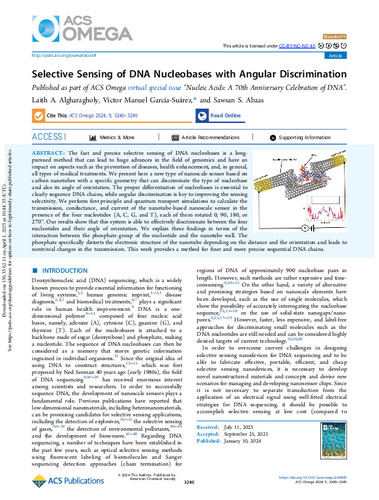Selective Sensing of DNA Nucleobases with Angular Discrimination
Autor(es) y otros:
Fecha de publicación:
Versión del editor:
Citación:
Descripción física:
Resumen:
The fast and precise selective sensing of DNA nucleobases is a long-pursued method that can lead to huge advances in the field of genomics and have animpact on aspects such as the prevention of diseases, health enhancement, and, in general,all types of medical treatments. We present here a new type of nanoscale sensor based oncarbon nanotubes with a specific geometry that can discriminate the type of nucleobaseand also its angle of orientation. The proper differentiation of nucleobases is essential toclearly sequence DNA chains, while angular discrimination is key to improving the sensingselectivity. We perform first-principle and quantum transport simulations to calculate thetransmission, conductance, and current of the nanotube-based nanoscale sensor in thepresence of the four nucleotides (A, C, G, and T), each of them rotated 0, 90, 180, or270°. Our results show that this system is able to effectively discriminate between the fournucleotides and their angle of orientation. We explain these findings in terms of theinteraction between the phosphate group of the nucleotide and the nanotube wall. Thephosphate specifically distorts the electronic structure of the nanotube depending on the distance and the orientation and leads tonontrivial changes in the transmission. This work provides a method for finer and more precise sequential DNA chains.
The fast and precise selective sensing of DNA nucleobases is a long-pursued method that can lead to huge advances in the field of genomics and have animpact on aspects such as the prevention of diseases, health enhancement, and, in general,all types of medical treatments. We present here a new type of nanoscale sensor based oncarbon nanotubes with a specific geometry that can discriminate the type of nucleobaseand also its angle of orientation. The proper differentiation of nucleobases is essential toclearly sequence DNA chains, while angular discrimination is key to improving the sensingselectivity. We perform first-principle and quantum transport simulations to calculate thetransmission, conductance, and current of the nanotube-based nanoscale sensor in thepresence of the four nucleotides (A, C, G, and T), each of them rotated 0, 90, 180, or270°. Our results show that this system is able to effectively discriminate between the fournucleotides and their angle of orientation. We explain these findings in terms of theinteraction between the phosphate group of the nucleotide and the nanotube wall. Thephosphate specifically distorts the electronic structure of the nanotube depending on the distance and the orientation and leads tonontrivial changes in the transmission. This work provides a method for finer and more precise sequential DNA chains.
ISSN:
Patrocinado por:
Iraqi Ministry of Higher Education and Scientific Research; University of Sumer; Iraqi Ministry of Education; MCIU/AEI/FEDER, EU [PGC2018-094783]
Colecciones
- Artículos [37541]
Ficheros en el ítem





